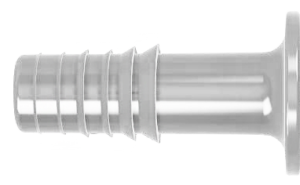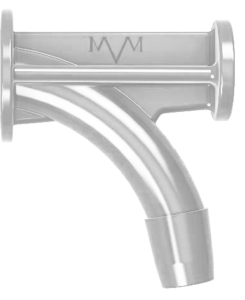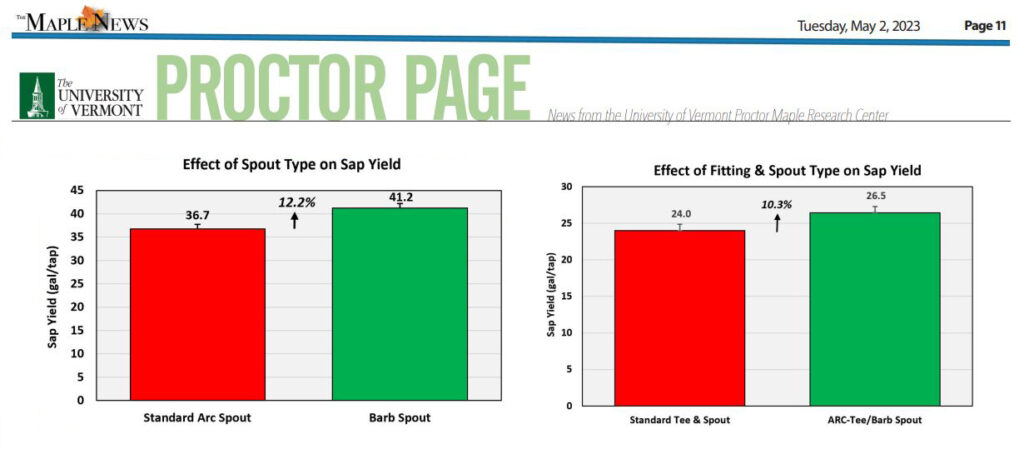The Science
Finding the sweet spot with a shorter barrel & barbs:
Sap flows into tapholes from severed vessels in the wood xylem. Due to the physiology of maple trees, the outer-most rings of xylem tend to be the most highly conductive of sap and also contain the highest concentration of stored sugar. Hydraulic conductivity, sap flow amount, and sap flow velocity, as well as sap sugar content all normally drop off with the age of the annual ring as we go deeper into the tree. Although it varies from tree to tree, sap flow at about 1.5” deep averages only about half that found at 0.5” deep and falls further to about 25% or less beyond 2” deep. This explains why drilling tapholes deeper than 2” deep results in little appreciable gain in sap yield (https://mapleresearch.org/pub/depth0321/).

Our Solution: Not only to get MORE sap out of tapholes, but to also get the sap out of a taphole FASTER.
Over the past five years we have examined several different approaches to reducing this restriction in sap flow from shallow tree rings in an attempt to increase sap yield and sugar content of collected sap. After exploratory research in 2018 and 2019, we settled upon a basic design starting in 2020 that in continued testing has proved successful.
The two main features of this new spout: Our shorter barrel and barbs.
Shortening the barrel of the spout reduces the amount of wood vessels that are blocked off by contact of the spout with the taphole and reduces the distance sap must be pulled to get around the obstruction. However, shortening the barrel reduces the stability of the spout in the taphole and could lead to a problem of heaving. A series of graduated barbs is used to prevent this. The spout is designed so that the first set of barbs engages in the xylem (wood) itself, close to, but inside of the cambium. The second set of barbs engages in the bark. The third set of barbs engages if the bark is thick and is also intended to provide a positive “stop” for spout seating, thereby limiting overdriving of spouts.
Read more about this at the Maple Research Organization: Innovations in Maple Sap Collection Systems: Spouts – Maple Research
Getting rid of the slug flow with beveled entrances & arcs:

The Problem: Sap and gases move together through lateral line tubing under vacuum. As this movement occurs, these two interact with each other and with the tubing in a fashion termed “slug flow,” a highly inefficient mode of liquid transport in pipeline systems.
A simple analysis of lateral line systems indicates some possible approaches to reducing friction to gas and liquid flow in lateral line systems. Vacuum and gravity “pull” sap down lateral lines. Friction “uses up” energy. The energy that is lost in this case is vacuum (gravity is constant). Reducing friction in the tubing system preserves energy and preserves vacuum further up the line. If making tubing larger or smoother due to cost or implementation issues, the next best way to reduce friction in tubing is to reduce turbulence, especially at fittings.
Our Solution: Two more simple modifications.
The first method is to incorporate a bevel into the entrance and exit of all fittings. This simple change “channels” sap flow better by reducing turbulence where tubing meets fittings. If sap encounters a beveled edge, it speeds up and smoothly transits the fitting where it exits smoothly with less turbulence.
The second modification is to incorporate an arc where sap streams meet. The simplest example is a tee. In most systems, sap flows down the lateral line from trees that are upstream, with sap entering from the dropline into the lateral line through a tee at a 90° angle to the lateral line. This creates a large amount of turbulence at the confluence of the two streams (the sap coming from the dropline and the sap running down the lateral line). This turbulence results in higher friction and reduced vacuum. The simple solution to this problem is to change the geometry of the tee. Y-fittings (30, 45, or 60°) reduce head loss by about 15-18%. Better still is an “ARC-flow” fitting configuration, which provides a smoothly curved flow path for sap from the dropline to enter into the lateral line stream.
Read more about this at the Maple Research Organization: Innovations in Maple Sap Collection Systems: Increasing Yield in 5/16” Lateral Line Tubing
– Maple Research
Keep the traffic flowing:
This type of fitting reduces head loss by about 50%. How?
Think of the lateral line as a heavily travelled highway with cars (sap) running down it quickly and smoothly. Air bubbles are the empty spaces between cars. What is the best way for more cars to enter traffic? Obviously, traffic flows better if cars enter via an entry ramp where they can merge smoothly into already flowing traffic. Having cars enter a busy highway at a right angle results in mayhem where all traffic slows down (or stops) and traffic is stop and go (turbulence). A smoothly curved onramp greatly reduces the turbulence of cars (or sap) entering the traffic (or sap) flow. To further the analogy, these frictional losses are additive. Each time sap has to merge (at a tee) or change direction (in a spout, a saddle, etc.), friction reduces the energy in the system, in a similar fashion that a lot of intersections in roads will reduce traffic speed and flow. In other words, the head losses build up and vacuum drops the further you move from the mainline in the lateral line system due to these restrictions.
It is important to note that changing intersections from a right angle to a curve will produce the greatest improvement in head loss. Thus using an arc-fitting wherever sap must change direction (spouts, saddles, etc.) would result in the highest degree of
improvement. Liquids tend to flow best in straight lines and create the most turbulence at confluences (tees) and where there is a change in direction. If we’re going to incorporate an arc into “tees,” then we might as well go full-in and also use the same design principle in all other components of the lateral tubing system (unions, saddles, etc.).
Check out our informational videos:
Check out more videos at the Proctor Maple Research Center: Proctor Maple Research Center YouTube Channel
Performance Testing:
2024 Testing: Cornell University: Arnot Research Forest
2023 Testing: The University of Vermont: Proctor Research Center

View the full article here: The University of Vermont Proctor Page: 2023 Season Barb Spout Results
The University of Vermont: Proctor Maple Research Center

Check out the Proctor Maple Research Center! UVM Proctor Maple Research Center
Check out more publications from the Proctor Maple Research Center! MapleResearch.org
